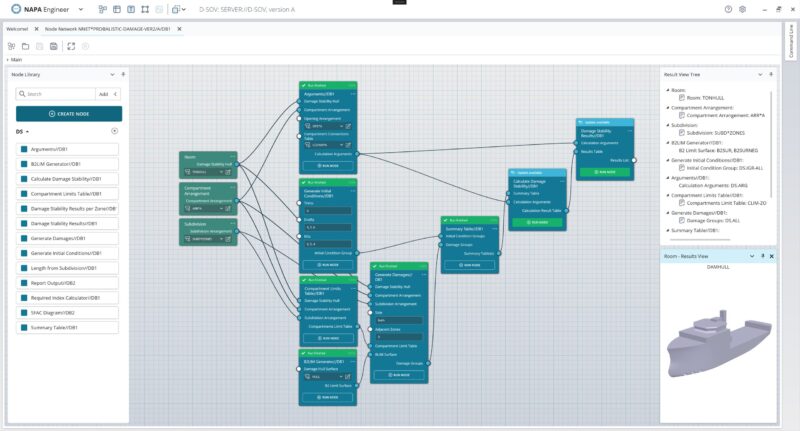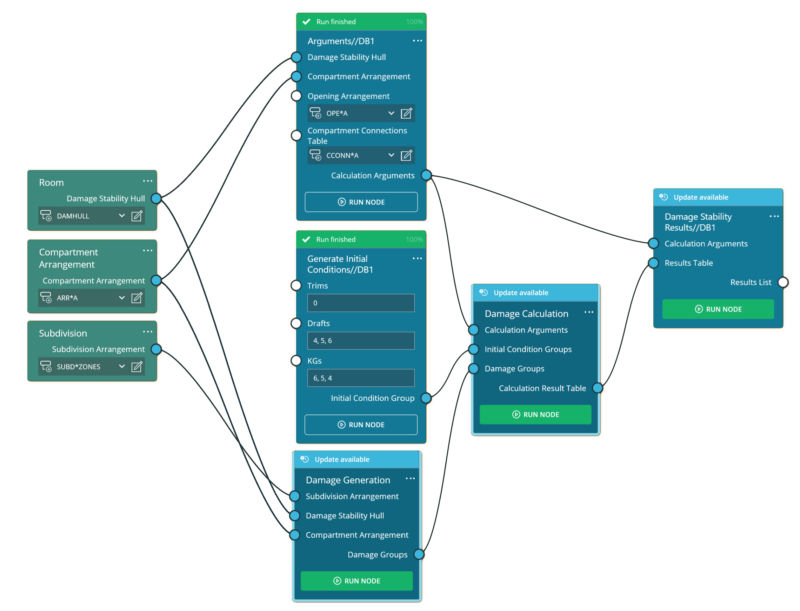May 9, 2025
Redefining ship design: How NAPA’s Node Network empowers naval architecture

NAPA is developing its next generation design platform – NAPA Engineer – to ensure Napa’s continued success in setting the standard for naval architecture and impacting the way we design ships across the globe. At the core of this new platform lies a powerful innovation: the NAPA Node Network.
Why change the design approach?
Ship design is becoming increasingly complex for naval architects due to new calculation methods,applicable novel innovations (for example needed to reduce greenhouse gas emissions), and to comply with increasing regulatory requirements on safety aspects and environmental considerations.
In this evolving landscape, improving the ship design performance on specific design aspects is a complex task where it is nearly impossible to foresee the consequences of design choices in a multi-disciplinary design-landscape.
As a result, design trade-offs are often resolved without exploring alternative solutions, often due to time constraints. Although holistic methodologies and algorithmic optimization are well understood in academia and remain underused in industry practice.
Meanwhile, user experience design has evolved rapidly in the past decade, emphasizing usability as a key factor in software reliability. Alongside new UX principles and technologies, the functional programming paradigm and low-code approaches have gained popularity in engineering software. User experience development and low-code systems enhance clarity, reduce maintenance effort, and improve robustness, critical for reliable vessel design analysis.
Enter the Node Network

The node network is NAPA’s answer to these growing demands and complexities. In NAPA Engineer, the ship design problem is organized in a node-network around a 3D product model of the vessel, it enables engineers to manage the ship design process using functional building blocks, or “nodes”, that each perform a specific calculation or task. These nodes can be connected and grouped into multi-level networks, making complex and multi-disciplinary calculations possible, while maintaining an easy overview for the naval architect. By utilizing nodes, node-groups and node-networks libraries, the naval architect is empowered to flexibly adapt large multi-disciplinary calculations in the node-network to suit specific project or company needs.
The node network offers:
- A visual and modular approach to modelling complex systems
- Reusability through customizable node libraries
- Clear data flow and dependency mapping between disciplines
- Holistic design support and readiness for algorithmic optimization
By organizing engineering logic into a node network, naval architects gain a powerful overview of the entire design process, one that can be easily adapted, grouped into sub-networks, and automated. Finally it supports to encompass all required naval architectural calculations, easy to tailor customization – as you could do with NAPA classic.
Empowering engineers at every level
While advanced naval architects can create sophisticated custom nodes, the system is equally approachable for newer users thanks to intuitive grouping nodes, a flexible UI, and support for pre-built functional blocks. This deliberate balance between powerful capabilities and ease of use makes the node network a scalable platform that evolves with its users – from initial concept design to regulatory compliance and performance optimization.
With the ability to integrate company-specific methods and standards, the node network also promotes standardization within organizations, reducing error and increasing collaboration between teams and disciplines.
Case: Designing Service Operation Vessel (SOV)
To validate the approach, the NAPA team implemented a real world case study using the node network to model:
- A parametric 3D product model of a Service Operation Vessel (SOV)
- Automated intact and damage stability calculations
- A hull transformation with associated geometry and stability updates
By chaining these together into a single workflow, the design team could quickly test design modifications, re-run calculations, and compare performance — all within a single, unified environment.
This test case revealed a key benefit of the system: once the node network is built, exploring the design space becomes as simple as updating a few parameters. And since each node operates as a functional and side-effect free component, the results remain consistent and reliable, perfect for connecting with optimization algorithms and AI-powered workflows.
Looking Ahead
NAPA’s node network approach blends decades of proven naval architectural methods with modern software principles. The result is a toolset that empowers naval architects to design smarter, faster, and with greater confidence.
As marine design software continues to evolve, the node network methodology offers a compelling foundation for the next generation of sustainable, high-performance vessel design.
The scope and potential of a node network approach was first presented at ICCAS.
NAPA Engineer is now available in Alpha version.
Join the growing community of early adopters and explore the latest developments as we build the future of naval architectural design — together. By participating in the community, you’ll get early access to new features, contribute feedback, and help shape how NAPA Engineer evolves to meet the needs of ship designers and engineers worldwide.